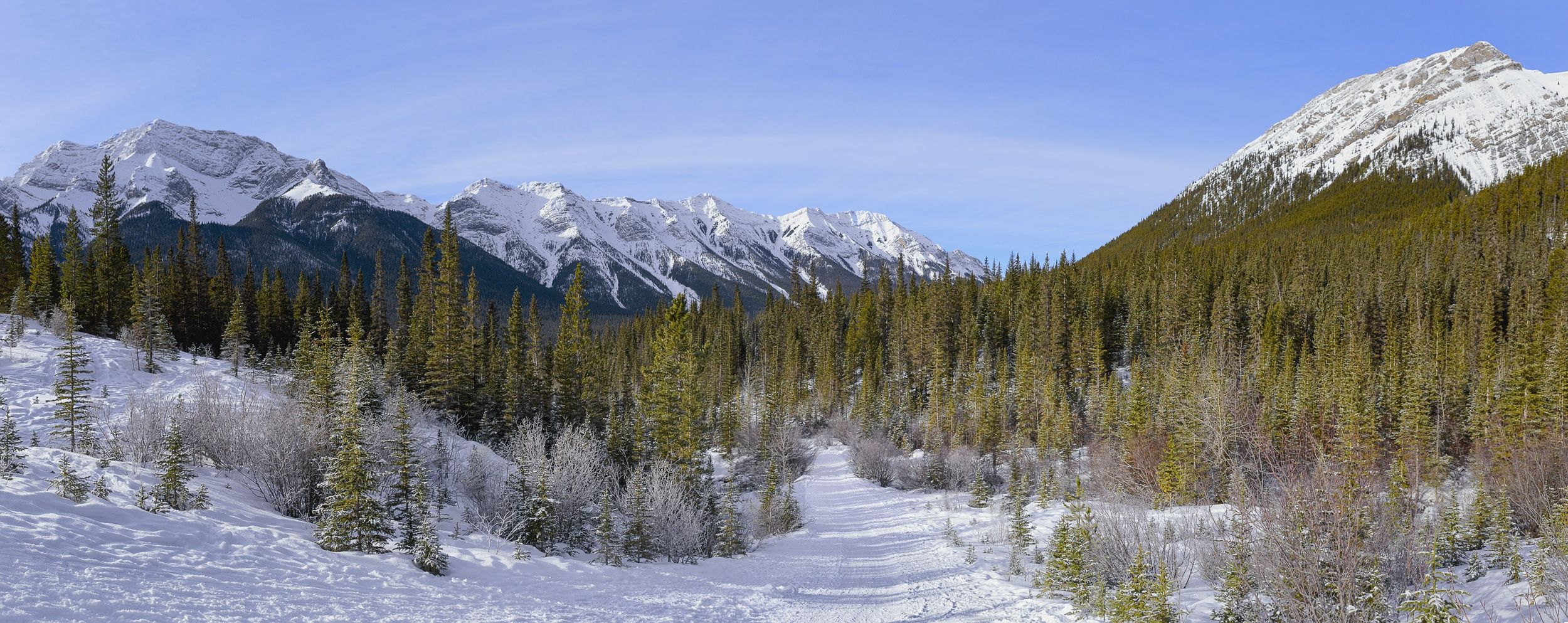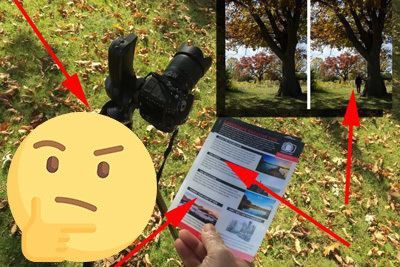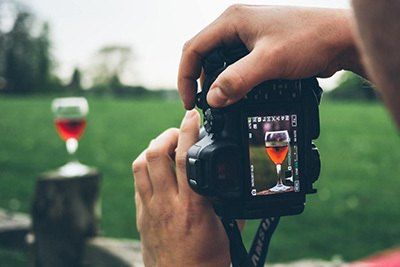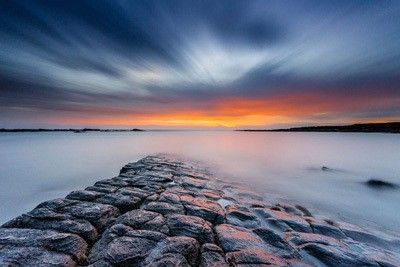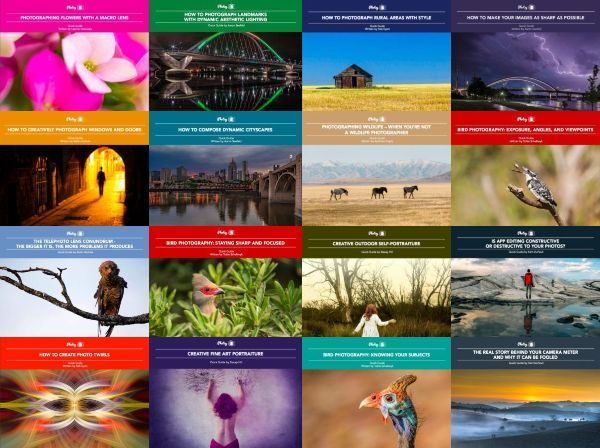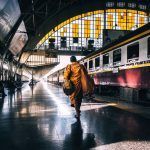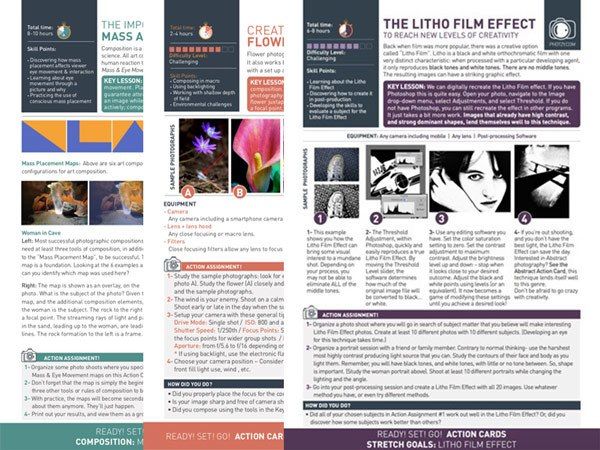Panoramic photography has been around since the 1800s and has always been popular with landscape photographers. In the past, you would have had to invest in some expensive equipment and spend considerable time in a darkroom to create one. Fortunately, the digital revolution in photography has made it much easier.
What we are going to talk about in this guide is how you can increase your prospects of achieving great panoramic images.
Even with the many advances in software, perfect results are not a given.
Capturing images in the field, which a software solution can successfully stitch together, takes some understanding.
In this article, we’ll discuss the equipment, tricks, techniques, and technical issues that you should consider. Yes, there will be some technical stuff, but I promise it’s easy! By the time you finish this article, you’ll have all the information that you need to capture images that will create beautiful panoramas.
So what are we going to discuss in this article?
- The advantages of a multi-shot panorama
- Required equipment
- A short cut to visualizing your end results
- What is Parallax – and why you should care!
- How to set up your camera for panoramic images
- How to prepare your images for stitching
Recommended Reading: If you’d like to learn more and improve your landscape photography, grab a copy of Photzy’s bestselling premium guide: Complete Landscape Photography.
Panorama Basics
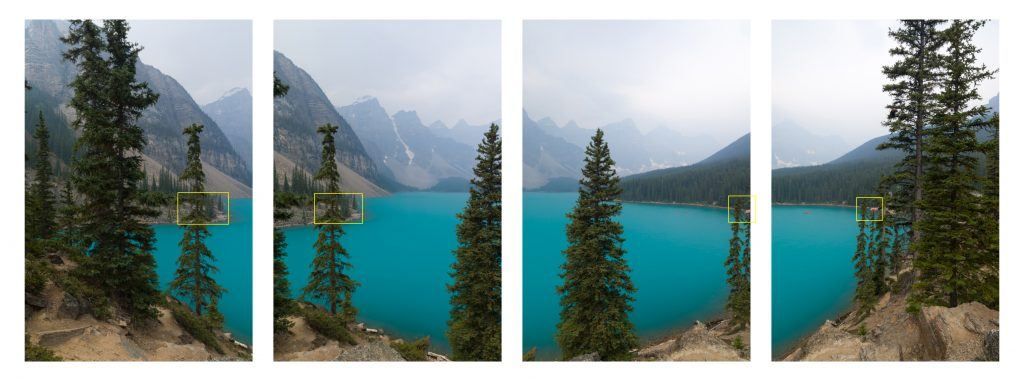
1.6 sec, f/16, ISO 100, 24mm, Canon 5D Mk IV
Early smoke-filled morning at Moraine Lake, Alberta, Canada. Photograph by Rob Eyers
Here’s an example of four images for making a panorama.
We’ll get back to why those yellow squares are there in a little while.
So, why take a bunch of pictures to make a panorama (pano) when you could just use a wide-angle lens and crop the top and bottom? The answer is detail, detail, detail!
Let’s say your camera is around 10 megapixels (MP) or so (yours likely has more MPs but bear with me for a moment). If you take one single image and crop 20% off the top and bottom, you’d be left with 60% of your pixels, or 6 MPs. If instead you take six 10 MP images, you’d have 60 MPs. With overlapping and cropping you’ll lose approximately 33%, leaving you with about 40 MPs. What you’re left with is over 6 times as many megapixels. That’s more than enough resolution for a 36-inch photo viewed at 2 feet. 6 MPs isn’t enough for a 10-inch-wide print viewed at 18 inches.
Key Lesson: By creating multi-shot panoramic photographs, you are left with a much larger file size than if you simply “cropped” a single frame.
You may have noticed that the four shots in the image above were taken in portrait orientation. The advantage of this is twofold: first, you’ll have more height to work with when cropping, and second, you’ll be able to fit more images into a given scene, thus yielding a higher resolution panorama.
Key Lesson: Shooting your multiple frames in a vertical (portrait) orientation has a distinct advantage over creating your frames in a horizontal orientation.
The example above is a single row of images, but you could take multiple rows to create an even larger image.
Let’s talk about equipment next.
Key Lesson: Many smartphones have a panoramic mode, or you can run a pano app. A quick panoramic photo (oftentimes referred to as a “pano”) with your phone can not only give you an idea of whether it is worth taking the shots with a higher resolution camera, but also indicate to you how to frame and compose the image. There is nothing worse than getting home only to find that you missed the shot because you didn’t capture what you needed.So, the phone you have in your pocket becomes the first bit of equipment you can use.

About The Camera
In addition, any decent digital camera will work for taking panos. Even a pocket camera with only 10 MPs can give decent results, as we discussed earlier. Of course, the better the camera, the better the results. Today’s DSLRs – with 20 MPs or more – are ideally suited for taking fantastic panos.
When it comes to lenses, you can use anything from 24 to 200mm. 50mm will yield an image much like what the human eye naturally sees. Wider lenses do give you more height when in portrait orientation, and depending on the landscape this may dictate the lens that you will choose.
The width of the scene doesn’t matter as you can always take more shots.
Wider lenses do give you more height when in portrait orientation, and depending on the landscape this may dictate the lens that you will choose.
It is possible to take your images handheld. If you do, you’ll need to use a faster shutter speed to avoid camera shake, which may compromise your ISO or aperture (f stop).
That said, a tripod is always better, which means you can choose a lower ISO setting and take longer exposures with an aperture that will give you the depth of field you require.
Specialized tripod pano heads are a must if you are serious about getting great results.
Key Lesson: Almost any camera can work for panoramic photography, even a cell phone camera. The lens choice is personal preference and typically dictated by the situation. A tripod, while not an absolute necessity, is a huge plus! Many tripods have the ability to change “heads.” The head is the part that connects to the camera. A panoramic head aids in panoramic photography.
Let’s get to those yellow boxes back in the photo earlier, and that will also explain what those specialized tripod panoramic heads can do for you.
Here comes the technical stuff.
The Parallax Effect
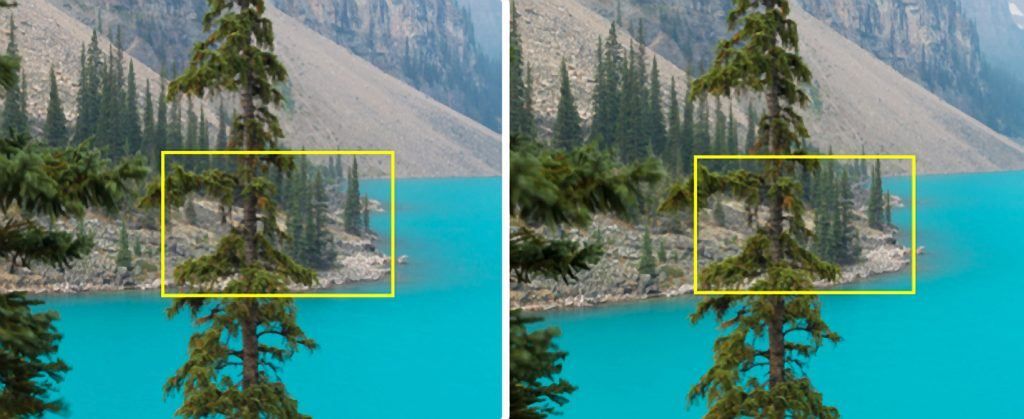
These images above are from the two left frames in the image earlier. Go back and take a second look and you’ll see that the foreground tree and the trees on the far shore are lined up in both images like they do here in the image on the left. This would not be the case if you hand held the camera and moved it from left to right between the 2 shots.
The reason for this is called parallax.
Parallax is the single most important thing to understand in panoramic photography, so let’s make sense of it.
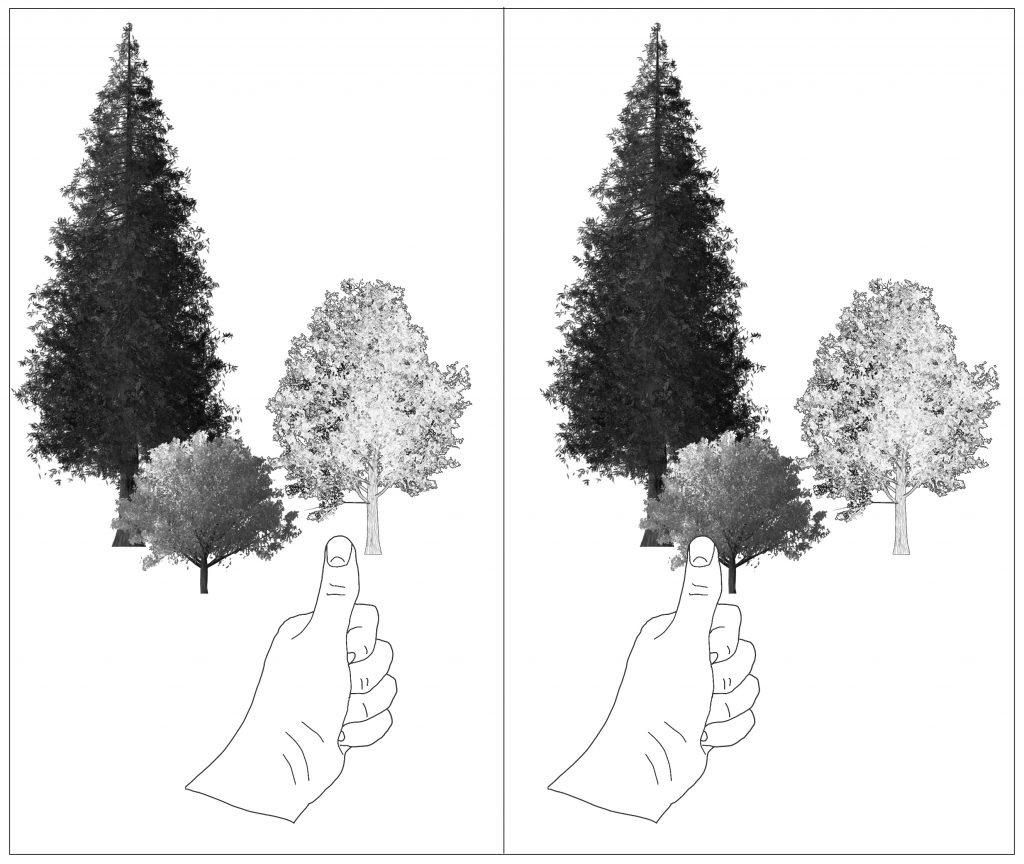
Graphic by Rob Eyers
Hold your hand out in front of you with your thumb extended and close your right eye. Line your thumb up with something in the distance.
Now don’t move your thumb, but close your left eye and open your right. Is your thumb still lined up? The answer is no, and the reason is an optical rule called “parallax.”
If you move your camera between shots, the alignment of the foreground to distant objects will change.
So why are the trees in the earlier images lined up? Let me explain.
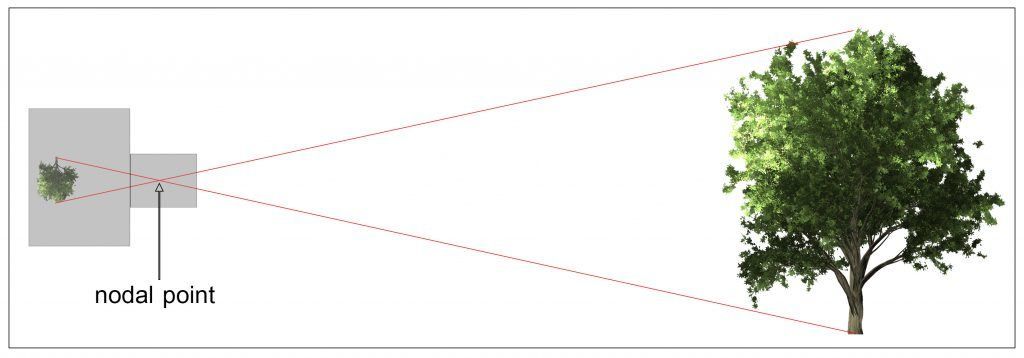
Graphic by Rob Eyers
The light passing through your camera lens goes through a point, which is commonly referred to as the nodal point (the technically correct name is the entrance pupil). This operates like your eye. Since there is only one lens/nodal point in your camera, keeping that nodal point in a fixed position will ensure there won’t be any shift in the foreground-to-background alignment. It would sort of be like using your right eye only and not moving your head to look at the whole scene.
Easy, right?
Well, maybe not so easy if you’re hand holding the camera!
Key Lesson: Parallax is a deviation that occurs if the camera position is allowed to wander. This is why a tripod is very helpful in panoramic photography.
So what’s the answer?
Panoramic Tripod Heads
The “ultimate” answer is a panoramic head mounted on top of a tripod.
These pano heads allow you to line up the nodal point of your lens with a pivot point on your tripod. Now, when you move your camera it swivels around that nodal point and everything in the foreground stays perfectly in line with the background. As a result, your software will be able to stitch your frames together with little to no errors.
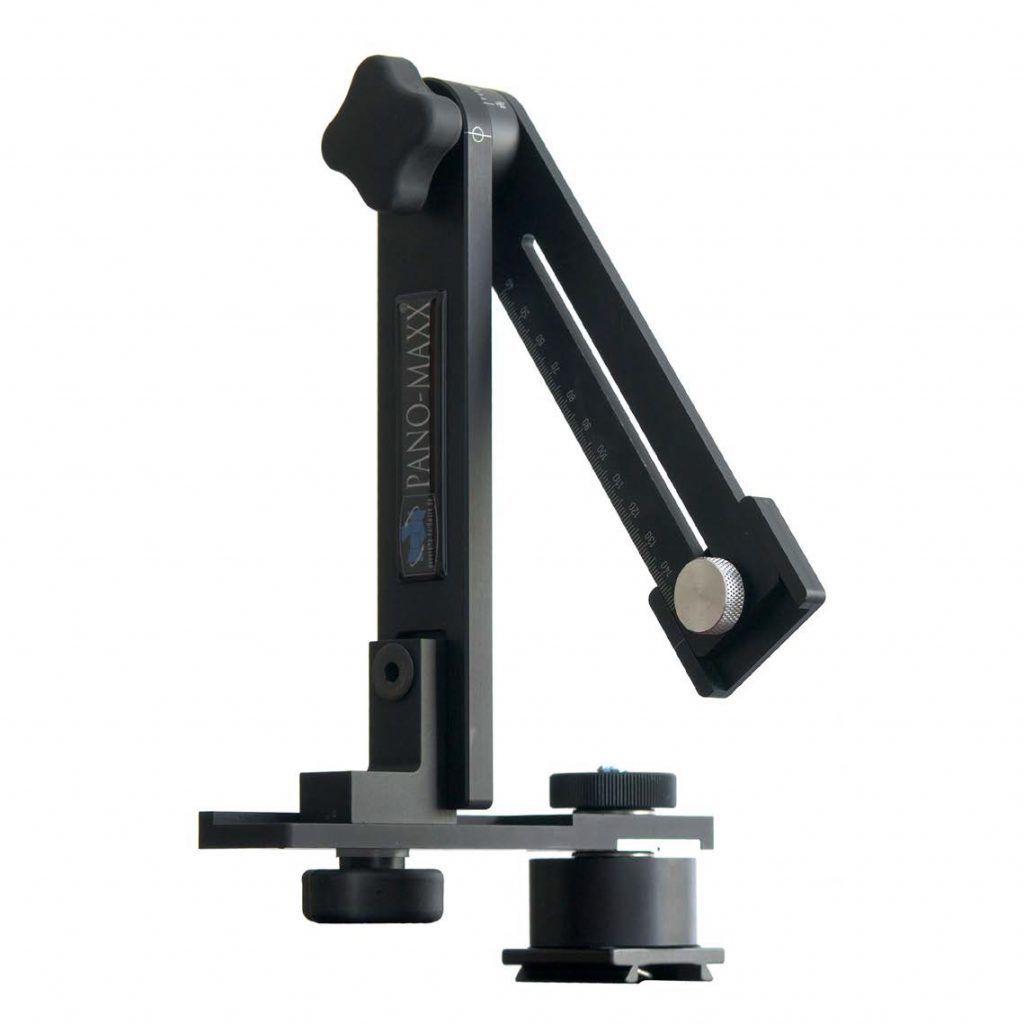
Photograph by Janne
Important Note: Parallax is more problematic if there is a strong structural item in the foreground with straight lines. If you are hand holding your camera and not using a tripod/ pano head, it’s a good idea to arrange your composition without strong structural items with a lot of straight lines in the foreground. The photo below is an example of a hand-held pano avoiding the issue as best as possible.
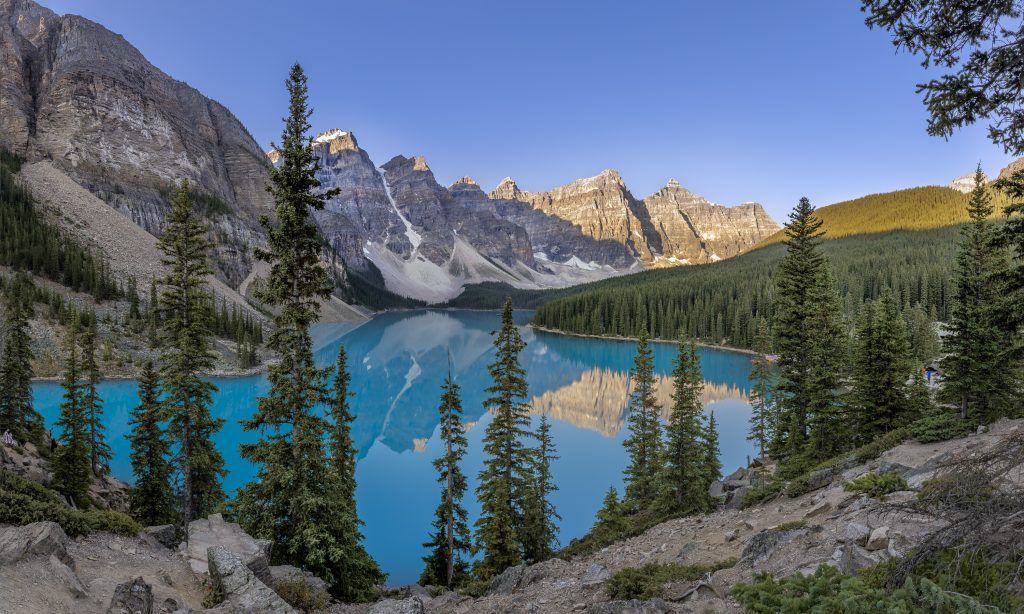
Key Lesson: Investing in a good tripod and panoramic head for your tripod can assist in your panoramic photography by keeping the “nodal point” in alignment with the “pivot point” as the camera is rotated while taking multiple frames.
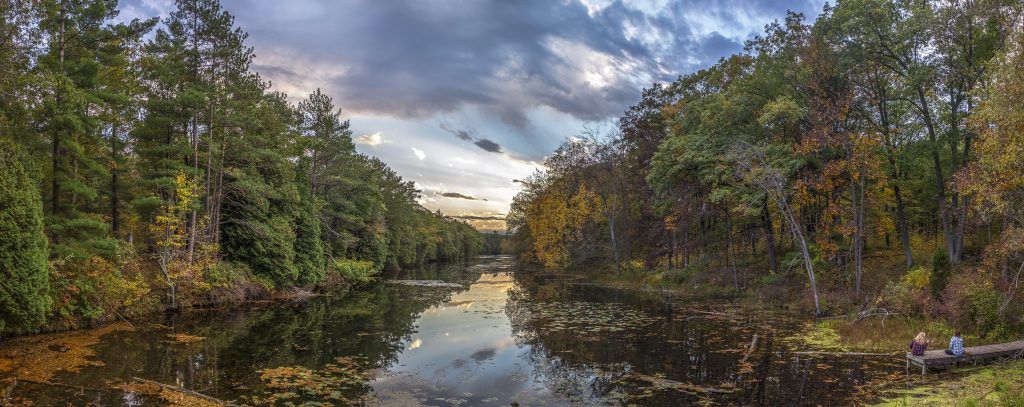
The Pinery Provincial Park, Ontario, Canada – 1/250, f/2.0, ISO 200, 23mm – Fujifilm X100T. Photograph by Rob Eyers
By understanding parallax, you’ll be able to create better, more aligned shots when you’re hand holding the camera.
Key Lesson: By pivoting on one foot with your camera positioned directly over the foot, you’ll get better results than just swinging from side to side as you take your sequence of shots. Try and think about the pivot point of your foot being the nodal point, and then simply do your best.
From this point on, we’ll assume you’re using a tripod and a pano head for the sake of the lesson.
If you Google ‘panoramic tripod head,’ you’ll find several companies making different models at varying prices.
You can even Google DIY videos if you’re on a budget.
For the record, I currently use panoramic heads produced by the company Really Right Stuff.

Quidi Vidi, Newfoundland, Canada – 1/200, f/11, ISO 100, 35mm – Canon 6D
The ropes on the boats in the center would have been a problem had I not used a panoramic head on my tripod and leveled the setup. Photograph by Rob Eyers
Whichever pano head you use, the first thing you’re going to need to do is to level it. From left to right, it needs to be level as you rotate your camera.
Recommended Reading: If you’d like to learn more and improve your landscape photography, grab a copy of Photzy’s bestselling premium guide: Complete Landscape Photography.
Exposure Settings For Panorama
Let’s now look at how exposure settings affect a panoramic photograph.
Some of the images used to make the pano above would have metered differently.
For example, the far left is darker than the boats in the middle.
Since the exposure setting must all be the same for every frame, you’ll have to make a decision about which exposure setting to choose based upon all the potential exposure readings obtainable within your scene.
If you scan the complete scene with your camera meter on, watching to see which portion has the brightest information, you can then set your exposure for that reading (brightest portion of the scene).
The important thing here is to not lose any detail in the final pano by overexposing and clipping out any highlights.
Since the exposure setting must all be the same for every frame, you’ll have to make a decision about which exposure setting to choose based upon all the potential exposure readings obtainable within your scene.
Using the Live View on your camera, with an RGB histogram turned on, can be very helpful in setting up your exposure. Use the visible histogram to confirm that none of the color channels are clipped.
You can easily find more information regarding this on the internet (Google: ‘how to use RGB histograms in Live View’).
Being on a tripod is also an advantage when you’re setting your exposure.
You can keep your ISO at a low setting to minimize the noise and use longer exposures.
Subject motion, such as the boats in the image earlier, might cause you to raise the ISO, but camera shake is taken out of the equation.

Grazalema, Andalucia, Spain – 1/250, f/8.0, ISO 1250, 24mm – hand held – Canon 6D
Grazalema is a long way to travel for a do over; at least it is for me! Photograph by Rob Eyers
If the scene has a high dynamic range, there’s nothing stopping you from bracketing your individual images for HDR processing. In fact, it’s not a bad idea to bracket your shots anyway, just in case you make a small error in setting your exposure. It’s happened to me, and I was glad I had the extra exposures as insurance.
Focusing
Just like the exposure setting must be consistent throughout all of the frames for the panorama, it’s also true that each frame must be shot with the same focal length lens and at the same focusing distance.
You can calculate the Hyperfocal Distance for your lens length and aperture, but an easier way that works well is to simply pick a point – about one third of the way into your scene – and use that as your focal distance.
For example, in the previous photo (above), that could be the bend in the road or the near buildings on the left.
Once you’ve chosen your target, you need to turn off auto focus so that the camera doesn’t readjust each time you press the shutter!
Key Lesson: Once you’ve chosen your focus point, do a critical focus and then turn the auto-focusing function off until you’ve completed all of your frames for the panorama. When you’re done, don’t forget to turn the auto-focusing back on.
Another way to stop your camera from refocusing is to use back-button focus.
The back-button technique sets your camera up to operate differently.
The focus function is removed from the shutter release button and placed on a button on the back of your camera.
With this technique, you don’t need to be concerned about turning auto-focus off, because the only time your camera will focus is when you press that back-button. It will not refocus when you release the shutter button.
Avoiding Camera Shake
- Make sure that you turn the image stabilization function off on your lens (if your lens has that feature). When on a tripod, the image stabilization function can cause your lens to shift during exposure, resulting in motion.
- The mirror movement inside the DSLR-style camera can cause a minor amount of vibration when you create an exposure. You can lock the mirror up, which is NOT recommended because you can no longer see the scene. When you use the Live View function the mirror is automatically locked up. Live View once again has an advantage for this reason. If you’re using a mirrorless camera, this is not an issue.
- Pressing the shutter release button can cause the camera to move slightly, so use a cable release or use the shutter delay self-timer.
- If you have a polarizing filter (or a daylight/ UV filter) on your lens, take them off. The polarizer will wreak havoc with the sky across your multiple exposures and look horrible. The daylight filter will also degrade your images a bit as well, so don’t use them when creating multiple-frame panoramas.
- What you definitely want to use is your lens hood! That device helps with lens flares and also gives your lens some protection against accidents.
Start Shooting
Now you’re ready to take your exposures.
You want to take all of your exposures in as short a time as you possibly can so the light is the same in all of them. Depending on conditions, the light and clouds can change quickly outdoors, which will complicate things for your software when you try and stitch the images together.
Start by taking your left exposure first, and make sure it’s well left of where you think it should be. Take note of what’s on the right side of the frame before you click the shutter release.
For the second shot, carefully rotate the camera to the right. Make sure you overlap the previous frame by about 30%. Continue taking the rest of your exposures following the same procedure: shoot, rotate, and overlap by 30%.
Do this until your last frame is well past where you anticipate your panoramic photograph to end.
Over-shooting your composition area is always a good idea: left and right as well as top and bottom. Having more than you need is a good thing when you’re cropping later. Compromising your composition because of missing subject matter is a disappointment.
Recommended Reading: If you’d like to learn more and improve your landscape photography, grab a copy of Photzy’s best-selling premium guide: Complete Landscape Photography.

An example of ghosting. Photograph by Rob Eyers
To stitch your images into a panoramic image, you’re going to use one of the many software products that are available.
Each of them will have their own advantages and disadvantages. The process is basically the same for all of them.
Choose the images that you want to stitch together, and then instruct the program to proceed with the stitching process.
You may also have the option to pick the type of stitching process that it will use.
Most programs have the option to pick how much “de-ghosting” is done to deal with anything that has moved slightly from frame to frame.
Over-shooting your composition area is always a good idea: left and right as well as top and bottom. Having more than you need is a good thing when you’re cropping later.
If there are subjects or objects that have moved a lot in your exposures, it may not be possible for any software to correct it. It’s best to avoid movement completely when taking your images.
I choose to use Lightroom to do my stitching. Lightroom version 2015 CC, or newer, has this function.
I prefer using Lightroom because the original captures can stay in the RAW format, and the stitched panoramic image remains in the RAW format as well.
This gives me all of the post-processing flexibility of the original files while doing my post-processing of the stitched panoramic image.
Key Lesson: By using Adobe Lightroom to stitch your individual frames together into one panoramic image, not only can you do camera RAW adjustments to each frame, but the final stitched image is also in the camera RAW format. This provides maximum flexibility!

Olhos de Agua, Algarve, Portugal. 1/160, f/11, ISO 100, 27mm. Photograph by Rob Eyers
Years ago, we visited the Grand Canyon. It’s one of those destinations that you look forward to… and that you aren’t really prepared for.
As we walked out of the parking lot on the South Rim and emerged from a small stand of trees, I took a huge involuntary gasp.
It just does that to you.
As I stood there, I heard others gasping as they emerged from the same trees.
I had my camera with me and I set about taking snapshots of the incredible beauty.
After arriving back home, it was disappointing to realize that those 4×3 snaps didn’t convey even 10% of the majesty of that place.
I wish I had known how to take a panoramic photograph back then!
Panoramas convey a sense of place better than any other type of image.
You know how to create them now, so get out there and capture some of those amazing places!

Ha Ling Peak Trailhead, Kananaskis, Alberta, Canada –
1/800, f/8.0, ISO320, 24mm, Canon EOS 6D. Photograph by Rob Eyers
Self-Check Quiz:
- True or False: Horizontal orientation is best for horizontal panos.
- What camera is best for taking panos?
- True or False: Image stabilization should be used on a tripod.
- What is the best kind of polarizing filter to use when taking panos?
- Why should you use manual mode for taking panos?
- Name three advantages of Live View when taking panos.
- True or False: It’s best to use a tripod when taking panos.
- What’s an easy rule to follow when deciding on where to focus?
- Why is it best to not have any structures in the foreground when taking a hand-held pano?
- How do you decide on the exposure for all of your frames?
- Why would you avoid capturing moving objects in your exposures?
- How much overlap is required when taking pano exposures?
- What is an easy way to find your pano exposures among all your images?
- True or False: It’s a bad idea to bracket your exposures.
- Why should you care about parallax?
Answers:
- False
- DSLR
- False
- Polarizing filters should not be used
- So your exposure values stay constant from frame to frame
- Histogram, zoom focusing, and mirror up
- True
- Focus on something about a third into your scene
- Parallax will cause your software to stitch them badly
- Set your exposure on the brightest frame of your scene
- To avoid stitching errors
- Approximately 30%
- Take a shot of your hand at the beginning and end of your sequence
- False
- Because you don’t want stitching errors caused by it


